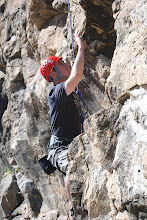 We gathered up the old crew (minus one Smiffy) and went indoor climbing this past weekend. I wanted to work out some techniques in the safety of the gym before we try it outdoors.
We gathered up the old crew (minus one Smiffy) and went indoor climbing this past weekend. I wanted to work out some techniques in the safety of the gym before we try it outdoors.I've been visualizing this for a few weeks now, trying to get my head around how to do it with one leg. The body mechanics of climbing are about using slow/strong/finesse movements, not jerky/hopping ones. Lucky for me, my technique was never all that great to begin with so starting over wasn't going to be a huge change!
Also handy was the fact that I signed the waivers and got my membership before the accident. When we came in to pay, the guy behind the counter took a long look and said "Guess you won't be climbing then huh", to which I cheerily replied, "you're damn right I am".
 Matt and I devised a way to protect the end of my stump using some packing foam with cut-outs to give the bone tip some breathing space. The MacGraham Boney Knub Protector 6000 is patent pending. A bit of high density foam and some tubi-grip is all we needed.
Matt and I devised a way to protect the end of my stump using some packing foam with cut-outs to give the bone tip some breathing space. The MacGraham Boney Knub Protector 6000 is patent pending. A bit of high density foam and some tubi-grip is all we needed. The climbing went really well. I did seven climbs and didn't fall once all night. The climbs were some of the easiest ones in the gym but it felt good to be back in action, even if it was indoor. I had a few stares but assumed it was probably due to my amazing physique and dashing good looks!
The climbing went really well. I did seven climbs and didn't fall once all night. The climbs were some of the easiest ones in the gym but it felt good to be back in action, even if it was indoor. I had a few stares but assumed it was probably due to my amazing physique and dashing good looks!I started out using far too much hopping and not enough strength. It didn't take long to get tired enough to start thinking about technique again. So here's what I learned...
 A quick "how-to" on climbing with one leg:
A quick "how-to" on climbing with one leg:- Keep your arms stretched above you at full reach. You can hang from outstretched arms all day. You're a hairless ape, get used to it -- that's why we have lats.
- Look for foot holds much more side-to-side than higher up. Don't do the giant hop to the next hold "up" as the motion may tear your hands free. Use a controlled "swing" to get the next one to the side, slightly higher than the one you're on.
- Turn your knee and foot inside to use the outer edge of the foot on the holds. This centers your weight and allows your knee some freedom to bend without putting you off balance.
 - As your leg gets higher, keep the arms stretched out rather than bending the elbows. Allow your body to "tent" out from the wall a bit until you can straighten the leg and stand up high enough to reach the next set of hands.
- As your leg gets higher, keep the arms stretched out rather than bending the elbows. Allow your body to "tent" out from the wall a bit until you can straighten the leg and stand up high enough to reach the next set of hands.- Abseiling down takes a lot more balance. Find your center and move the leg back and forth to keep you from barn-dooring.
- Remember, you're indoors, this isn't real climbing and your life isn't on the line: protect the stump at all costs.
This might sound strange, but I really want to enjoy this period of time between getting my new leg and losing my old one. It's a huge challenge and it comes with a lot of problem solving. I've been enjoying it in a perverse sort of way. Exploring the phantom sensation and discovering that the brain has more to do with pain than the body does has been fascinating!
UPDATE: Here's the video of my third climb. I was still trying to work out a technique so don't pay too much attention to form. I stayed on the blues to make it more challenging (harder than yellows) but I did far more (too many) big hops than I needed to. This burns out the leg and makes it difficult to go the distance.

Cool.
ReplyDeleteThis is a sport I have heard we amputees can really kick ass at. Just wait till you are holding a miniature foothold with a toe that never gets tired....
I have yet to try it myself but am interested now....
Cheers,
Gr8 to have you back climbing you are an inspiration to everyone around you. I told you we would get you back on the wall ;)
ReplyDeleteYou make it look too easy!
ReplyDeleteawesome. I wanted to google one legged climbing because I got a bad sprained ankle and I still want to keep climbing while I recover. Thanks!
ReplyDelete